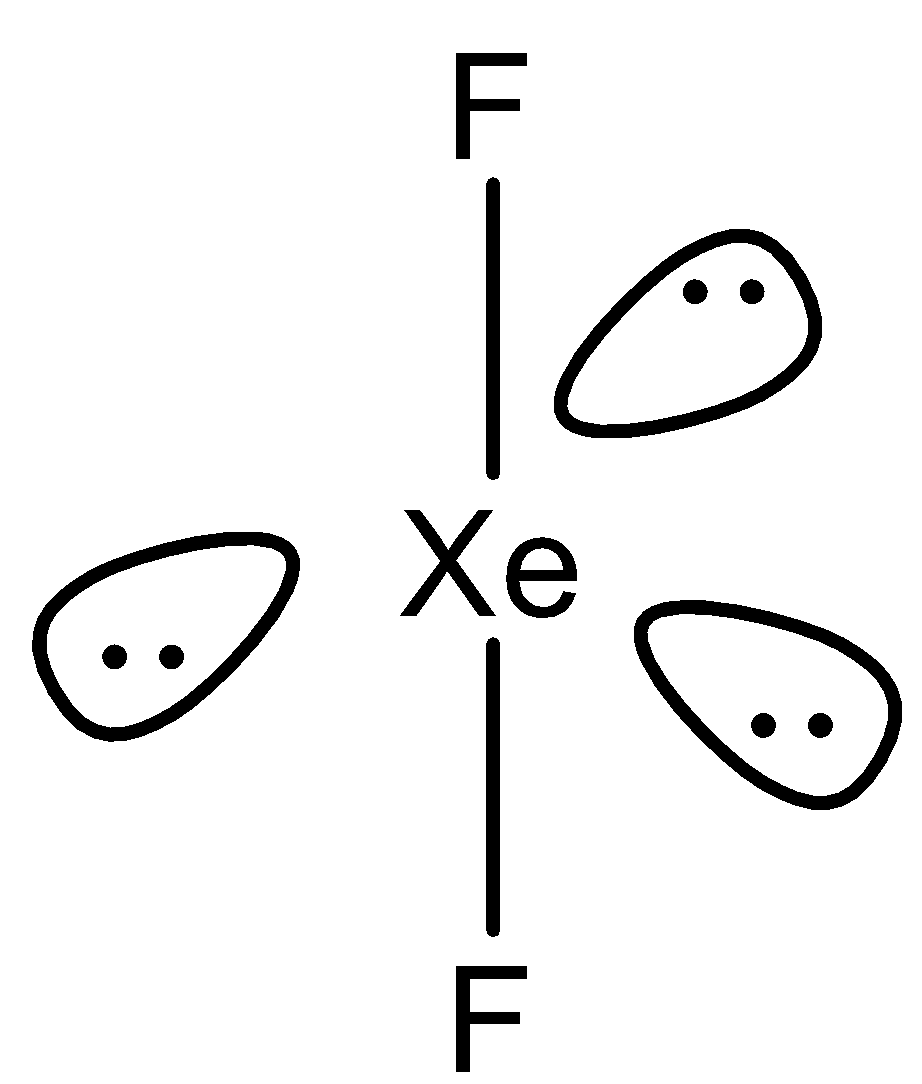
The hybridization and shape of $ Xe{F_2} $ is:
(A) $ s{p^3} $ , bent
(B) $ ds{p^2} $ , linear
(C) $ s{p^3}{d^2} $ , linear
(D) $ s{p^3}d $ , linear
Answer
548.7k+ views
Hint: We know that in chemistry hybridization or orbital hybridization is defined as the concept of mixing or merging atomic orbitals to form a new hybrid orbital which is also known as the hybridized orbital. With the help of hybridization, we can also predict the shape or the geometry of the molecule.
Complete step by step answer:
Now we know about the basic concept of hybridization in which two atomic orbitals are combined to form a hybrid orbital. So, now we will study the hybridization of the molecule $ Xe{F_2} $ . The hybridization of a molecule and the shape of a molecule depends on the central atom of the molecule. So, the central atom in the molecule $ Xe{F_2} $ is xenon $ Xe $ . Now we will write the electronic configuration of Xenon which is $ Xe \to [Kr]4{d^{10}}5{s^2}5{p^6} $ . The electronic configuration of the central atom helps us to find the number of valence electrons. So here according to the electronic configuration of Xenon, we can observe that it has a stable noble gas electronic configuration. So, the number of valence electrons in Xenon is $ 8 $ . Now we will study the chemical structure $ Xe{F_2} $ .

From the above structure we can observe that out of the $ 8 $ electrons, $ 2 $ electrons are bonded with fluorine atoms and the rest six electrons form three electron pairs. Now to predict the hybridization we count the sum of a total number of bonded atoms and the lone pairs over the central atom. So here, the sum is $ 5 $ . So, the hybridization $ Xe{F_2} $ will be $ s{p^3}d $ which means $ 1s $ , $ 3p $ and $ 2d $ orbitals are used. The shape $ Xe{F_2} $ is linear.
Therefore, the correct option is (D).
Note:
The shape of the molecule $ Xe{F_2} $ can be easily explained with the help of its structure. The shape is such that the lone pairs around the central atom acquire the equatorial position and the bond angle is $ {180^0} $ . Therefore, the shape is linear.
Complete step by step answer:
Now we know about the basic concept of hybridization in which two atomic orbitals are combined to form a hybrid orbital. So, now we will study the hybridization of the molecule $ Xe{F_2} $ . The hybridization of a molecule and the shape of a molecule depends on the central atom of the molecule. So, the central atom in the molecule $ Xe{F_2} $ is xenon $ Xe $ . Now we will write the electronic configuration of Xenon which is $ Xe \to [Kr]4{d^{10}}5{s^2}5{p^6} $ . The electronic configuration of the central atom helps us to find the number of valence electrons. So here according to the electronic configuration of Xenon, we can observe that it has a stable noble gas electronic configuration. So, the number of valence electrons in Xenon is $ 8 $ . Now we will study the chemical structure $ Xe{F_2} $ .

From the above structure we can observe that out of the $ 8 $ electrons, $ 2 $ electrons are bonded with fluorine atoms and the rest six electrons form three electron pairs. Now to predict the hybridization we count the sum of a total number of bonded atoms and the lone pairs over the central atom. So here, the sum is $ 5 $ . So, the hybridization $ Xe{F_2} $ will be $ s{p^3}d $ which means $ 1s $ , $ 3p $ and $ 2d $ orbitals are used. The shape $ Xe{F_2} $ is linear.
Therefore, the correct option is (D).
Note:
The shape of the molecule $ Xe{F_2} $ can be easily explained with the help of its structure. The shape is such that the lone pairs around the central atom acquire the equatorial position and the bond angle is $ {180^0} $ . Therefore, the shape is linear.
Recently Updated Pages
Why are manures considered better than fertilizers class 11 biology CBSE

Find the coordinates of the midpoint of the line segment class 11 maths CBSE

Distinguish between static friction limiting friction class 11 physics CBSE

The Chairman of the constituent Assembly was A Jawaharlal class 11 social science CBSE

The first National Commission on Labour NCL submitted class 11 social science CBSE

Number of all subshell of n + l 7 is A 4 B 5 C 6 D class 11 chemistry CBSE

Trending doubts
Differentiate between an exothermic and an endothermic class 11 chemistry CBSE

10 examples of friction in our daily life

One Metric ton is equal to kg A 10000 B 1000 C 100 class 11 physics CBSE

Difference Between Prokaryotic Cells and Eukaryotic Cells

1 Quintal is equal to a 110 kg b 10 kg c 100kg d 1000 class 11 physics CBSE

State the laws of reflection of light




